Huawei Technologies U7510 HSDPA/UMTS/GPRS/GSM Mobile Phone with Bluetooth User Manual U7510 User Guide
Huawei Technologies Co.,Ltd HSDPA/UMTS/GPRS/GSM Mobile Phone with Bluetooth U7510 User Guide
User Manual
Wonderful Communication,
Mobile Life.
User Guide

Introduction
About This Guide . . . . . . . . . P1
Frequency Band . . . . . . . . . . P1
Packing List . . . . . . . . . . . . . . P1
SIM Card and Memory Card . P2
Charging the Battery . . . . . . . P3
Appearance of Your Phone . . P5
Home Screen . . . . . . . . . . . . P7
Using the Touch Screen . . . . P8
Calibrating the Screen . . . . . . P9
Dragging and Flicking . . . . . . P9
Accessing the Widget Bar . . P10
Security . . . . . . . . . . . . . . . . P10
Text Input
Handwriting Mode . . . . . . . . P12
On-screen Keyboard Mode . P13
Customized Settings
Profiles . . . . . . . . . . . . . . . . P14
Phone Settings . . . . . . . . . . P14
Display Settings . . . . . . . . . P15
Network Settings . . . . . . . . . P15
Call Service
Contacts . . . . . . . . . . . . . . . P16
Making a Call . . . . . . . . . . . P17
Answering or Rejecting a Call P19
Call Settings . . . . . . . . . . . . P19
Messaging
Sending a Message . . . . . . P21
Viewing a Message . . . . . . . P22
Message Settings . . . . . . . . P22
Sending an Email . . . . . . . . P22
Viewing an Email . . . . . . . . . P23
Email Settings . . . . . . . . . . P24
Entertainment
Playing Music or Video . . . . P25
Using Camera or Video Camera
. . . . . . . . . . . . . . . . . . . . . . . P25
Using FM Radio . . . . . . . . . P26
Games & Applications . . . . . P26
Business
Viewing the Calendar . . . . . P27
Creating a Reminder . . . . . . P27
Creating a Note . . . . . . . . . . P27
Managing files . . . . . . . . . . . P28
Creating an Alarm . . . . . . . . P28
Synchronizing Data . . . . . . . P29
Using Other Tools . . . . . . . . P29
Connectivity
Installing PC Suite . . . . . . . . P30
Connecting via USB . . . . . . P31
Connecting via Bluetooth . . P33
Using Bluetooth Headset . . P34
Accessing the Internet . . . . . P35
Contents

Warnings and Precautions
Electronic Device . . . . . . . . P36
Medical Device . . . . . . . . . . P36
Potentially Explosive Atmospheres
P36
Traffic Security . . . . . . . . . . P37
Operating Environment . . . . P38
Preventing Hearing Damage P39
Safety of Children . . . . . . . . P39
Accessories . . . . . . . . . . . . . P39
Battery and Charger . . . . . . P39
Clearing and Maintenance . P40
Emergency Call . . . . . . . . . . P42
Certification Information (SAR)
. . . . . . . . . . . . . . . . . . . . . . . P42
FCC Statement . . . . . . . . . . P43
Disposal and Recycling
Information . . . . . . . . . . . . . P43
Reduction of Hazardous
Substances . . . . . . . . . . . . . P44
EU regulatory conformance P44

Notice
Copyright © Huawei Technologies Co., Ltd. 2009. All rights reserved.
No part of this document may be reproduced or transmitted in any form or
by any means without prior written consent of Huawei Technologies Co.,
Ltd.
The product described in this manual may include copyrighted software of
Huawei Technologies Co., Ltd and possible licensors. Customers shall not
in any manner reproduce, distribute, modify, decompile, disassemble,
decrypt, extract, reverse engineer, lease, assign, or sublicense the said
software, unless such restrictions are prohibited by applicable laws or such
actions are approved by respective copyright holders under licenses.
Trademarks and Permissions
, HUAWEI and are trademarks or registered trademarks of Huawei
Technologies Co., Ltd.
Other trademarks, product, service and company names mentioned are
the property of their respective owners.
Notice
Some features of the product and its accessories described herein rely on
the software installed, capacities and settings of local network, and may
not be activated or may be limited by local network operators or network
service providers. Thus the descriptions herein may not exactly match the
product or its accessories you purchase.
Huawei Technologies Co., Ltd reserves the right to change or modify any
information or specifications contained in this manual without prior notice
or obligation.
NO WARRANTY
THE CONTENTS OF THIS MANUAL ARE PROVIDED “AS IS”. EXCEPT
AS REQUIRED BY APPLICABLE LAWS, NO WARRANTIES OF ANY
KIND, EITHER EXPRESS OR IMPLIED, INCLUDING BUT NOT LIMITED
TO, THE IMPLIED WARRANTIES OF MERCHANTABILITY AND
FITNESS FOR A PARTICULAR PURPOSE, ARE MADE IN RELATION
TO THE ACCURACY, RELIABILITY OR CONTENTS OF THIS MANUAL.
TO THE MAXIMUM EXTENT PERMITTED BY APPLICABLE LAW, IN NO
CASE SHALL HUAWEI TECHNOLOGIES CO., LTD BE LIABLE FOR
ANY SPECIAL, INCIDENTAL, INDIRECT, OR CONSEQUENTIAL
DAMAGES, OR LOST PROFITS, BUSINESS, REVENUE, DATA, GOOD-
WILL OR ANTICIPATED SAVINGS.
Import and Export Regulations
Customers shall comply with all applicable export or import laws and regu-
lations and will obtain all necessary governmental permits and licenses in
order to export, re-export or import the product mentioned in this manual
including the software and technical data therein.

Safety Precautions
Please read the safety precautions carefully to ensure the correct and safe
use of your wireless device. For detailed information, refer to the section
“Warnings and Precautions”.
Do not switch on your phone when it is prohibited to use
mobile phones or when the phone may cause
interference or danger.
Do not use your phone while driving.
Follow any rules or regulations in hospitals and health
care facilities. Switch off your phone near medical
apparatus.
Switch off your phone in aircraft. The phone may cause
interference to control signals of the aircraft.
Switch off your phone near high-precision electronic
devices. The phone may affect the performance of these
devices.
Do not attempt to disassemble your phone or its
accessories. Only qualified personnel are allowed to
service or repair the phone.

Do not place your phone or its accessories in containers
with strong electromagnetic field.
Do not place magnetic storage media near your phone.
Radiation from the phone may erase the information
stored on them.
Do not put your phone in a high- temperature place or
use it in a place with flammable gas such as a gas
station.
Keep your phone and its accessories away from
children. Do not allow children to use your phone
without guidance.
Use only approved batteries and chargers to avoid the
risk of explosions.
Observe any laws or regulations on the use of wireless
device. Respect others’ privacy and legal rights when
using your wireless device.
Strictly follow the relevant instructions in this manual
while using the USB cable. Otherwise your phone or PC
may be damaged.

Introduction
1
1 Introduction
About This Guide
This guide describes how to find and use the functions of menus of your
phone. If you customize the main menu, you can find and use the menus
according to your customized path.
Contacts > Desired item. In standby mode, access the main menu. Select
Contacts > Options > Desired item.
All the pictures in this guide are for reference only.
For certain network settings, such as the settings of the Email, MMS, Java,
and APN parameters, and the WAP address, you may need to obtain the
related details from your mobile service provider.
Frequency Band
Your phone can operate in virtually all countries, automatically switching
between WCDMA 2100 and GSM/GPRS 900/1800/1900 networks.
Packing List
Your phone package box contains the following:
• One HUAWEI U7510 mobile phone
• One Li-ion battery

2
Introduction
• One travel charger
• One USB data cable
• One User Guide
• One Headset (Optional)
SIM Card and Memory Card
Load your SIM card before using your phone. Only unload the SIM card
and the battery after powering off your phone. To use the SIM card prop-
erly, please read the following instructions carefully.
NOTE:
•Keep the SIM card out of the reach of children.
•The SIM card and its metal contacts can be easily damaged by
scratching or bending. Ensure care when you carry , load or remove it.
•Always disconnect the charger from the phone before loading or
removing the SIM card.
Your phone supports a memory card (microSD) with a capacity up to 8 GB.
To load or remove the memory card, remove the battery cover.
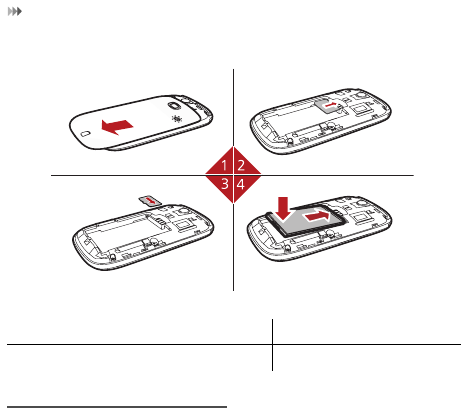
Introduction
3
The following figures show the installation of the SIM card and memory
card.
Charging the Battery
NOTE:
•The battery discharges even while not being used. If you have not
used it for a long time, please recharge it first.
1 Remove the battery cover. 2 Install the SIM card.
3 (Optional) Install the memory card. 4 Install the battery.

4
Introduction
•The battery can be recharged but eventually wears out. If the battery
lasts for a shorter time period than usual after being charged normally,
replace it with a battery of the same type.
•The charging time depends on the environmental temperature and the
age of the battery.
•When the battery power level is very low, the phone makes alert
sounds and displays a prompt. When the battery power level is too
low, the phone will power off automatically.
Before charging the battery, ensure that the battery has been properly
loaded into your phone.
1. Connect the USB interface of the USB cable to the travel charger.
2. Plug in the travel charger to a power socket.
3. Connect the mini USB interface of the USB cable to the charger
connector of your phone. When the battery is being charged, the
charging indicator blinks continuously.
4. When the charging indicator stops blinking, it indicates that the battery
is full.Disconnect the charger connector from the power socket.
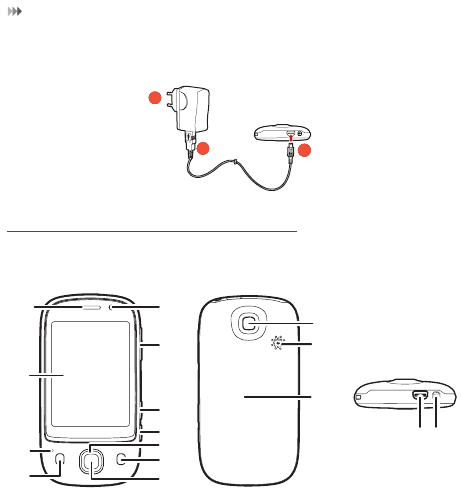
Introduction
5
5. Disconnect the USB cable from the phone.
Appearance of Your Phone
2
3
1
1
2
3
45
6
7
11
12
13
14
15 16
8
9
10
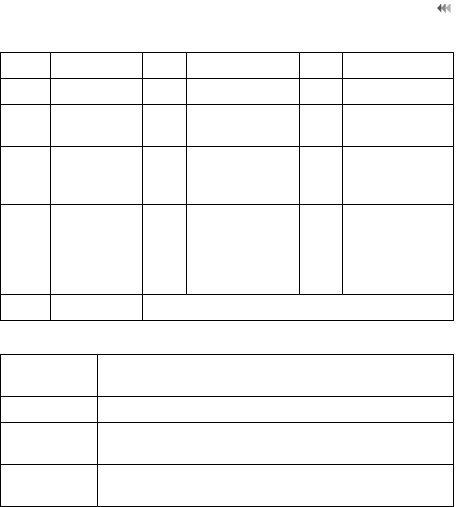
6
Introduction
1 Earpiece 2 Touch Screen 3 Microphone
4 Send Key 5 OK Key 6 End Key
7 Navigation
Keys
8 Camera Key 9 GPS shortcut
key
10 Volume
Up/Down
Key
11 Internal
Camera
12 Battery Cover
13 Speaker 14 Main Camera 15 Charger
connector /
Cable
connector /
Headset Jack
16 Power Key
Send Key • Make or answer a call.
• Access the Calls screen in standby mode.
OK Key Confirm a selection.
End Key • End an ongoing call or reject an incoming call.
• Return to the standby mode.
Camera
Key
Activate the camera in standby mode when the
screen is unlocked.
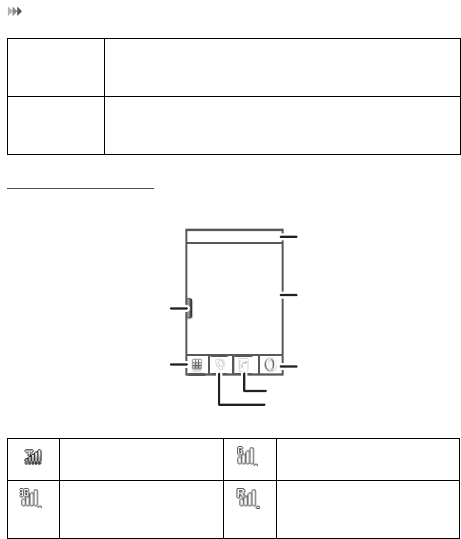
Introduction
7
Home Screen
GPS
shortcut
key
Activate the GPS application in standby mode when
the screen is unlocked.
Power Key • Press and hold it to power on or power off the
phone.
• Press it to lock or unlock the touch screen.
Indicates signal
strength.
The phone is currently in
the GSM network.
The phone is currently
in the WCDMA
network.
You are using the
roaming service.
Icon bar
Tap it to access Widget Bar
Tap it to access the browser
Desktop
Tap it to access Contacts
Tap it to access the dialer
Tap it to access main menu
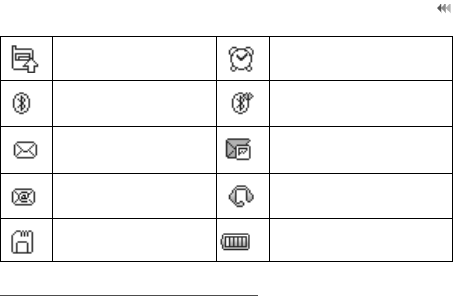
8
Introduction
Using the Touch Screen
You can select an item or enter text by using the stylus or tapping the touch
screen.
NOTE:
• Tap the icon accurately to select item.
• Tap gently to protect your touch screen.
• When the screen is locked, press the power key to unlock the touch
screen.
• When the screen is locked, press the send key, the OK key or the end
key to light the screen, and then unlock the screen by pressing and
holding the icon according to the instructions on screen.
The phone is in a call. Alarm clock is enabled.
Bluetooth is enabled. Bluetooth connection is
created currently.
You have new text
messages.
You have new multimedia
messages.
You have new Emails. The headset is plugged.
Memory card is
inserted.
Indicates power level of
the battery.

Introduction
9
Calibrating the Screen
When operating the phone with the stylus, if the phone cannot respond to
your operation correctly, calibrate the screen as follows.
1. Select Settings> Touch settings> Calibration to access the screen
for calibration.
2. Calibrate the screen by tapping the center of calibration frame
displayed on the screen according to the instructions.
NOTE: During the calibration, tap the center of calibration frame accu-
rately, to ensure that the phone can respond to your tapping and text entry
on the screen correctly after the calibration.
Dragging and Flicking
On the following screens, you can perform certain operations conveniently
through dragging on the touch screen.
• On the standby screen, tap and drag the profile or date to change the
position of the selected item.
• On the standby screen, tap and drag the widgets to change the posi-
tion of the selected item.
• In the menu list, drag up or down to scroll. Then tap a submenu to
select it.
• When viewing pictures, flick right or left to switch a picture to the next
or previous one.

10
Introduction
Accessing the Widget Bar
The widget bar provides quick access to the most frequently used items.
1. Tap the widget bar tab located on the left side of the desktop to open
the widget bar.
2. Tap the item on the widget bar to use it.
3. Tap the widget bar tab again to close the widget bar.
NOTE: You can drag a widget to the desktop or drag it back to the widget
bar.
Security
Select Settings> Security> Phone and SIM card> Desired item.
• Enter the password of your phone to restore factory defaults. The
initial password is 0000.
• If the phone lock or PIN lock is enabled, you need to enter the corre-
sponding password when you switch on your phone.
• Change the password of your phone, PIN code, or PIN2 code. The
PIN code can be changed only when the PIN code is unlocked.

Introduction
11
• Set the fixed dialer number list to define the numbers that your phone
can dial. This function needs to be supported by the SIM card.
NOTE:
• For certain SIM cards, you need to enter the PIN2 code to use certain
special functions.
• If you enter a wrong PIN code or wrong PIN2 code for three consecu-
tive attempts, the SIM card is locked. To unlock the SIM card, enter
the PIN Unblocking Key (PUK) code or PUK2 code.
• If you enter a wrong PUK code or a wrong PUK2 code for ten consec-
utive attempts, the SIM card is invalidated permanently, and only
emergency calls are permitted. Consult your service provider to
unlock the SIM card.
• The PIN code, PIN2 code, PUK code, or PUK2 code is provided
together with the SIM card. For details, consult your service provider.
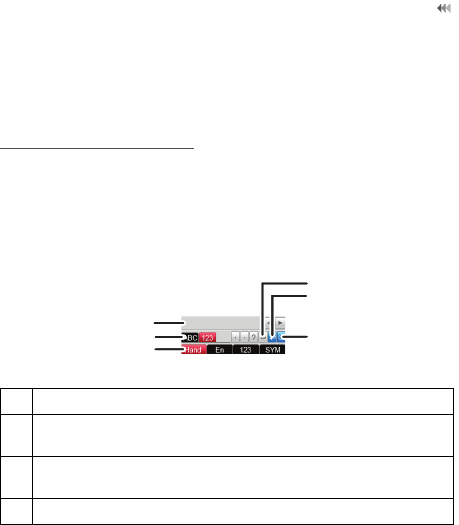
12
Text Input
2 Text Input
Your phone supports the handwriting input mode and on-screen keyboard
input mode.
Handwriting Mode
In handwriting mode, the following bar is displayed at the bottom of the
screen.
You can tap keys on the on-screen keyboard to enter corresponding
letters, numbers, or symbols.
1 Candidate character area
2 Tap here to select the English handwriting input mode or the
input of numbers.
3 Tap here to select the handwriting input mode, English input
mode, or the input of numbers and symbols.
4 Tap here to insert a space.
1
2
3
6
5
4
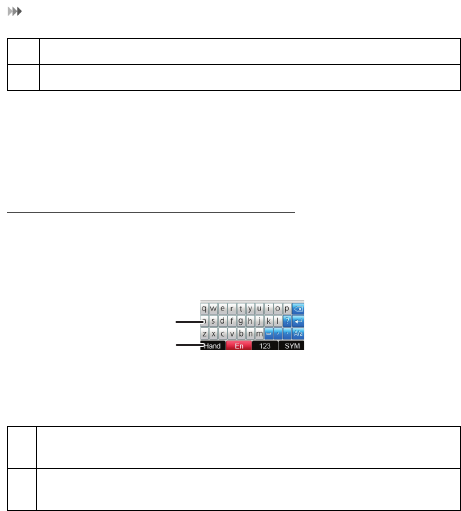
Text Input
13
1. When you write words or numbers on the screen according to the
intended order, the candidate character area displays the corre-
sponding candidate words or numbers.
2. Select the intended word or number in the candidate character area.
On-screen Keyboard Mode
In on-screen keyboard mode, the following bar is displayed at the bottom
of the screen.
You can tap keys on the on-screen keyboard to enter letters, numbers, or
symbols.
5 Tap here to insert a line feed.
6 Tap here to delete the letter before the cursor.
1
On-screen keyboard: Tap keys on the keyboard to enter letters,
numbers, or symbols.
2 Text input mode: Tap En, 123, or SYM to enter letters, numbers,
or symbols through the on-screen keyboard.
1
2

14
Customized Settings
3 Customized Settings
Profiles
You can set different profiles according to different scenarios.
• On the standby screen, tap the profile to edit it.
•Select Settings > Profiles > Desired item. Select a profile. Then,
press the OK key to enable the profile or select Edit to modify the
profile.
Phone Settings
Settings > Phone settings > Desired item. You can set the following:
• System time of your phone.
• Language of your phone.
• Sound options of your phone.
• Keypad tones.
• Enabling of automatic keypad lock.
• Enabling and time of automatic switching on or off.

Customized Settings
15
Display Settings
Settings > Display settings > Desired item, you can set the following:
• Wallpaper in standby mode
• Brightness of the screen
• Enabling of keypad backlight
• Period when the backlight is on
• User name
• Greeting messages
Network Settings
Settings > Network > Desired item. You can set the following:
• Network mode
• Manual or automatic network selection
• Enabling of the cell information
• Preferred operators

16
Call Service
4 Call Service
Contacts
Your can save or manage the information about contacts in the Contacts
function. You can also set a contact number as a speed dialing number.
Adding a Contact
1. Select Contacts > New Contacts.
2. Enter the information about the contact.
3. Select Save to save the contact.
Searching for a Contact
1. Select Contacts.
2. Tap the search bar to enter the contact name you are searching for.
3. The contacts with the information you enter is listed.
You can also use quick search in the contacts list screen. You can find a
contact by entering the initials of the first name or the last name of the
contact. For example, to find a contact named "Alice Green", enter the
initials "a" or "g". This contact is displayed in the candidate list.
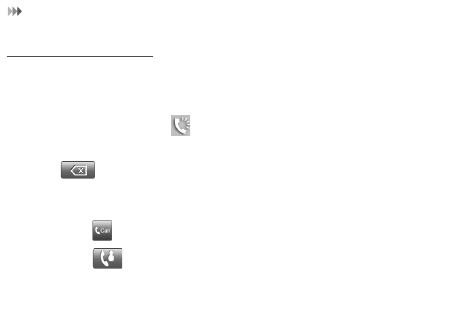
Call Service
17
Making a Call
Making a Call from Keyboard
1. In standby mode, tap to open the dialer.
2. Enter the phone number on the dialer. If you enter a wrong number,
tap to erase the number.
3. To make a call, perform either of the following operations:
• Tap to make a voice call.
• Tap to make a video call.
4. Press the end key to terminate a call.
NOTE:
•In the 3G network, you can make video calls, provided that the called
party has a device supporting the video call function.
• During a call, you can select Options to perform operations in the
option list.
Making a Call from Contacts
1. Access Contacts.

18
Call Service
2. Select the desired contact.
3. To make a call, perform either of the following operations:
• Tap to make a voice call.
• Press the send key to make a voice call.
• Select Options > Call > Call/Video call to make a call.
Making a Call from Call History
You can view all the missed calls, received calls, or dialed numbers in call
history.
1. Access Calls.
2. Select the desired call history.
3. To make a call, perform either of the following operations:
• Press the send key to make a voice call.
• Select Options > Call/Video call to make a call.

Call Service
19
Answering or Rejecting a Call
When there is an incoming call, press the send key to answer the call, or
press the end key to reject the call. You can set the any key answer mode
or auto answer mode.
1. Select Settings > Call settings > General > Answer mode to set the
answer mode.
2. You can answer a call according to your settings.
Call Settings
For the availability of call forwarding, call waiting and call barring, consult
your service provider.
Select Settings > Call settings, you can enable or disable the preceding
functions.
Select Settings > Call settings > General > Desired item, you can set the
following:
• Prompt of saving unknown numbers.
• Automatic redialing after a call fails.
• Answering mode of incoming calls.
• Automatic answering mode.
• Displaying of your number to the called party.
If you set it to automatic, the displaying is subject to your network.

20
Call Service
• Calling line of your mobile phone.
• Set My number.
You can create, edit, or delete your records.
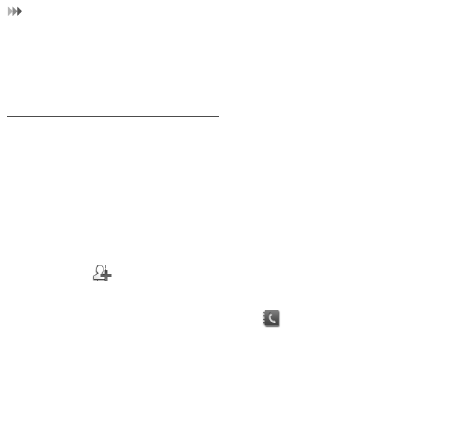
Messaging
21
5 Messaging
Sending a Message
1. Select Messaging > Create message to create a message.
2. When you edit a message, you can tap the icons at the bottom of the
screen to insert pictures or other files.
3. After the message is completed, perform either of the following oper-
ations to add a recipient:
• Tap , and then select Add from contacts or Enter number
to add a recipient.
• Press the OK key, and then tap to add a recipient from
Contacts.
• Press the OK key, and then enter a number.
4. Select Send to send the message.
NOTE: The screen displays the number of words or bytes of a message.
If the number exceeds the maximum, a message is sent as a series of two
or more messages.

22
Messaging
Viewing a Message
Your phone provides four mailboxes for messages. Inbox stores received
messages. Drafts stores created and saved messages. Outbox stores the
messages that failed to be sent. Sent stores sent messages.
1. Select a mailbox from Messaging. Then switch between four mail-
boxes and templates through the scroll key.
2. Select a message, and then select Options to perform the operations
of the option list.
NOTE: If your phone is enabled with the broadcast function, select
Messaging > Broadcast inbox to view broadcast messages.
Message Settings
1. Select Messaging > Settings > SMS&MMS or Settings > Applica-
tions > Message Settings > SMS&MMS.
2. Set the parameters related to messages.
NOTE: Select Messaging > Settings. You can also change the settings
of Push message, Broadcast or Common phrases.
Sending an Email
1. Select Email > Create Email to create an email.

Messaging
23
2. Select To. Select Add from contacts or Enter recipient to select an
email address.
3. Select Subject to edit the contents.
4. Select Text message to edit the content.
5. In the email editing screen, select Options to perform the operations
in the option list.
6. In the email editing screen, select Options > Send to send the email.
Viewing an Email
Your phone provides five mailboxes for emails. Inbox stores received
emails. Drafts stores created and saved emails. Outbox stores the emails
failed to be send. Sent stores sent emails. Blocked stores screened
emails.
1. Select a mailboxes from Email. And then switch among five
mail-boxes through the scroll key.
2. Select an email, and then select Options to perform the operations of
the option list.

24
Messaging
Email Settings
Settings > Applications > Email settings > Desired item, or Email >
Email Wizard > Desired item. Then, you can set the email account. Select
an account, and then choose Options.
• You can edit an account and set general, incoming, or outgoing attri-
butes.
• You can add a new account.
• You can set an account to the default account.

Entertainment
25
6 Entertainment
Playing Music or Video
1. Select music files, video files, or playlists.
2. Press the OK key to play music or video.
3. During playing, you can perform the following operations:
• Press the OK key to pause or resume the playing.
• Tap the icons on the player screen to control the player.
• Select Exit to exit from the player.
NOTE: During music playing , select Options > To background to return
to the standby screen. Then the player plays the song at the background.
The screen displays the name of the current song on the status bar of the
player. You can tap the status bar to access the player again or tap the
close icon to exit from the player.
Using Camera or Video Camera
1. Press the camera key or select Camera to launch the camera.
2. In the viewfinder screen, you can tap the icons to perform the desired
operations.

26
Entertainment
3. In the viewfinder screen, press the camera key or OK key to take a
picture or record a video clip.
• When recording a video clip, you can pause or continue
recording.
• When recording a video clip, press the camera key or OK key to
stop recording and save the video.
4. After taking a picture or recording a video clip, you can tap the icons
on screen to perform the desired operations.
Using FM Radio
1. Connect the headset to your phone.
2. Select Entertainment > FM Radio.
3. If the channel list is empty, select Options > Automatic turning /
Manual turning to set channels.
4. Select Options > Exit to exit from FM radio.
Games & Applications
You can install and run Java applications on your phone. For details,
please refer to the help of the applications.

Business
27
7 Business
Viewing the Calendar
1. Select Tools > Calendar, and then select the desired date.
2. Press the OK key or tap the selected date to view the reminder.
3. Select Options to create a reminder, set the view mode, jump to a
date, synchronize data, view undue reminders, and search the
calendar.
Creating a Reminder
1. Select Tools > My Reminders.
2. Click the tab on the upside of the screen to change categories.
3. Select Options > Desired item, to create reminders, view categories,
or search reminders.
Creating a Note
Select Tools > Memo > New memo to create a new note.
1. Select Tools > Memo and select a note.

28
Business
2. Click Options to edit, send or delete the note.
Managing files
1. Select My Files > Desired item to manage pictures, music files, video
clips, documents, ringtones, and other files.
2. Select a file folder, and then select Options > Desired item to perform
operations in the option list.
When your phone find the memory card, the memory card tab is automat-
ically displayed on the folder screen. Select the desired contents in the
memory card and perform corresponding operations. In addition, your
phone supports the function of formatting the memory card.
Creating an Alarm
1. Select Tools > Alarms > New alarm to set an alarm.
2. You can select an alarm from the alarm list, and then select corre-
sponding option to activate, deactivate, or delete the alarm.
3. When it is time for an alarm clock to ring, the selected alarm tone is
played and a prompt is displayed. You can stop the ringing or snooze
the alarm.
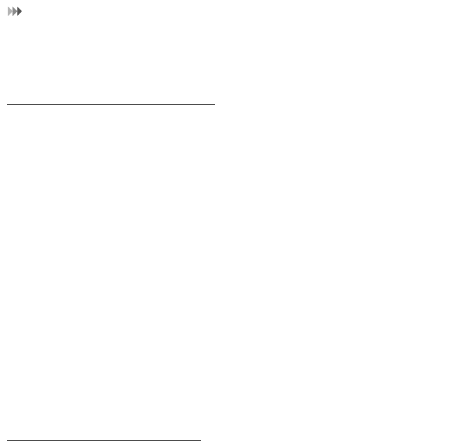
Business
29
NOTE: If your phone is powered off, the alarm clock will still ring. When
the alarm rings, you can choose to power on the phone.
Synchronizing Data
You can synchronize information between your phone and the server
through the wireless network. The information that can be synchronized
includes the contacts, calendar, and to-do list. This service requires
network support. For details, consult your service provider.
1. Select Tools > Synchronize.
2. Tap the arrows on the upper part of the screen to switch among
Synchronize, Settings, and Log.
•Synchronize: You can synchronize Contacts, Event & Anni-
versary, and Task.
•Settings: You can connect to the server or set the synchroniza-
tion direction.
•Log: You can view logs.
Using Other Tools
Your phone also provides Calculator, Converter, World Time, Stop-
watch, Timer, and Service Dial Number in Tools.

30
Connectivity
8 Connectivity
Installing PC Suite
The PC Suite software supplied on your phone runs automatically after you
connect your phone to the PC with the USB cable.
1. Connect your phone and PC with the USB cable.
2. Wait for the dialog box to appear.
3. Select the desired button to install the software.
4. Follow the wizard to complete the installation.
5. When the installation is complete, wait for the modem driver to be
displayed in the modem list on your PC.
6. Restart your PC to finish the installation.

Connectivity
31
Connecting via USB
USB-based Synchronization
You can synchronize data between your phone and PC. With a USB cable
and the PC assistant, your phone can communicate with a PC. To perform
the USB-based synchronization with your phone, do as follows.
1. Connect your phone and PC with the USB cable.
2. Run the PC Suite on the PC.
3. Now you can perform the USB-based synchronization. For details,
refer to the Help of the PC Assistant.
USB-based Internet Access
Connecting your phone to the PC with the USB cable enables the PC to
use the phone as a modem. This helps to set up a dial-up connection to
the Internet.
Only Windows 2000, Windows XP and Windows Vista are supported.
1. Connect your phone and PC with the USB cable.
2. Ensure the USB device is displayed in Device Manager/Port of your
PC.
3. Select one of the following methods to set up the dial-up connection.
• Run the Dial-up Internet on the PC to create the dial-up connection.

32
Connectivity
• Create Internet access through the built-in Internet wizard of the
Windows operating system.
• Install and tun the dial-up internet wizard application supplied on your
phone. For details, refer to the Help of the application.
microSD Card Reader
You can read the files saved in the microSD card by using a USB cable.
NOTE:
•The function of the microSD card reader and the other functions using
the USB cable are incompatible. If you enable the microSD card
reader, other functions using the USB cable are unavailable.
•Your phone can switch to the microSD card reader mode only in
standby mode.
1. Insert the microSD card into your phone.
2. Connect your phone to the PC with the USB cable.
3. The PC Options software supplied on your phone runs automati-
cally.Then select File Transfer.
4. Found New Hardwareis displayed on your PC, and an icon for the
mobile memory drive is displayed. Then you can read the files stored
in the microSD card directly.

Connectivity
33
Connecting via Bluetooth
Bluetooth-based Synchronization
To perform the Bluetooth synchronization with your phone, your PC needs
to support the Bluetooth function.
1. Select Bluetooth to enable the Bluetooth function, and then select
Discoverable > Yes.
2. Run the driver software for Bluetooth on the PC, and pair the phone.
After the PC detects the phone serial port service, activate the Blue-
tooth serial port service on the phone.
3. You can now perform the synchronization. For details, refer to the
Help of the PC Assistant.
Bluetooth-based Internet Access
Connecting your phone to a PC through the Bluetooth function enables the
PC to use the phone as a modem. This helps to set up a dial-up connection
to the Internet.
To access the Internet through Bluetooth, make sure that your PC
supports the Bluetooth function and your SIM card supports the Internet
access service.
You can create Bluetooth-based Internet access through the built-in
Internet wizard of the Windows operating system, or the Internet wizard
supplied with the Bluetooth drive suite of the PC.
NOTE: Windows 2000, Windows XP and Windows Vista are supported.

34
Connectivity
Bluetooth-based Data Transfer
You can exchange data between your Bluetooth phone and other Blue-
tooth devices. If you want to exchange data between your phone and
another device, that device must support Bluetooth and the Bluetooth func-
tion must be enabled.
1. Select Bluetooth to enable the Bluetooth function.
2. Select Search devices to search a Bluetooth device. When a Blue-
tooth device is found for the first time, authentication is required.
3. Now you can exchange data between your phone and the other Blue-
tooth device.
Using Bluetooth Headset
You can talk by using the Bluetooth headset or Bluetooth loudspeaker. For
more information, refer to the user manuals of related devices.
1. Open the Bluetooth headset and keep it in the discoverable state.
2. Select Bluetooth to enable the Bluetooth function.
3. Select Search devices to search a Bluetooth device. When a Blue-
tooth device is found for the first time, authentication is required.

Connectivity
35
Accessing the Internet
1. Select Opera mini or Entertainment > Browser to access the
internet.
2. You can perform the following when browsing:
• Opening the homepage
• Entering a website to access and connect to it
• Saving or editing frequently visited websites
• Browsing saved web pages offline
• Browsing history web pages
• Connecting to the website lately accessed
• Setting the Browser

36
Warnings and Precautions
9 Warnings and Precautions
This section contains important information pertaining to the operating
instructions of your device. It also contains information about how to use
the device safely. Read this information carefully before using your device.
Electronic Device
Power off your device if using the device is prohibited. Do not use the
device when it causes danger or interference with electronic devices.
Medical Device
• Power off your device and follow the rules and regulations set forth by
the hospitals and health care facilities.
• Pacemaker manufacturers recommend that a minimum distance of 15
cm be maintained between a device and a pacemaker to prevent
potential interference with the pacemaker. If you are using a pace-
maker, use the device on the opposite side of the pacemaker and do
not carry the device in your front pocket.
Potentially Explosive Atmospheres
Power off your device in any area with a potentially explosive atmosphere,
and comply with all signs and instructions. Areas that may have potentially
explosive atmospheres include the areas where you would normally be
advised to turn off your vehicle engine. Triggering of sparks in such areas
could cause an explosion or fire, resulting in bodily injuries or even deaths.

Warnings and Precautions
37
Do not switch on the device at refueling points such as service stations.
Comply with restrictions on the use of radio equipment in fuel depots,
storage, and distribution areas, and chemical plants. Also, adhere to
restrictions in areas where blasting operations are in progress. Before
using the device, watch out for areas that have potentially explosive atmo-
sphere that are often, but not always, clearly marked. Such locations
include areas below the deck on boats, chemical transfer or storage facil-
ities and areas where the air contains chemicals or particles such as grain,
dust, or metal powders. Ask the manufacturers of vehicles using liquefied
petroleum gas (such as propane or butane) if this device can be safely
used in their vicinity.
Traffic Security
Observe local laws and regulations while using the device. Also, if using
the device while driving a vehicle, please comply with the following guide-
lines:
• Concentrate on driving. Your first responsibility is to drive safely.
• Do not talk on the device while driving. Use hands-free accessories
• When you have to make or answer a call, park the vehicle at the road
side before using your device.
• RF signals may affect electronic systems of motor vehicles. For more
information, consult the vehicle manufacturer.
• In a motor vehicle, do not place the device over the air bag or in the
air bag deployment area. Otherwise, the device may hurt you owing
to the strong force when the air bag inflates.

38
Warnings and Precautions
• Do not use your device while flying in an aircraft. Switch off your
device before boarding an aircraft. Using wireless devices in an
aircraft may be dangerous to the operation of the aircraft, disrupt the
wireless telephone network, and may be considered illegal.
Operating Environment
• Do not use or charge the device in dusty, damp or dirty places or
places with magnetic fields. Otherwise, the circuit may not function
properly
• The device complies with the RF specifications when the device is
used near your ear or at a distance of 1.5 cm from your body. Ensure
that the device accessories such as a device case and a device
holster are not composed of metal components. Keep your device 1.5
cm away from your body to meet the requirement earlier mentioned.
• On a thunder and stormy day, do not use your device when it is being
charged, to prevent any danger caused by lightning.
• When you are on a call, do not touch the antenna. Touching the
antenna affects the call quality and results in increase in power
consumption. As a result, the talk time and standby time are reduced.
• While using the device, observe the local laws and regulations, and
respect others' privacy and legal rights.
• Keep the ambient temperature between –10 ℃ and 45 ℃ while the
device is being charged. Keep the ambient temperature between –10
℃ to 55 ℃ for using the device powered by battery.

Warnings and Precautions
39
Preventing Hearing Damage
Listening to a headset at high volumes can damage your hearing. Use only
the minimum volume setting necessary to hear your conversation or
music.
Safety of Children
Please comply with all precautions with regard to children's safety. Letting
the child play with your device or its accessories, which may include parts
that can be detached from the device, may prove dangerous, as it may
present a choking hazard. Make sure that small children are kept away
from the device and accessories.
Accessories
Use only the accessories delivered by manufacturer. Using accessories of
other manufacturers or vendors with this device model might invalidate any
approval or warranty applicable to the device, might result in the non-oper-
ation of the device, and might be dangerous.
Battery and Charger
• Unplug the charger from the electrical plug and the device when not
in use.
• The battery can be charged and discharged hundreds of times before
it eventually wears out. When the standby time and talk time are
shorter than normal, replace the battery.

40
Warnings and Precautions
• Use the AC power supply defined in the specifications of the charger.
An improper power voltage may cause fire or the charger may not
function properly.
• Do not connect two poles of the battery with conductors such as metal
materials, keys or jewelries. Otherwise, the battery may be
short-circuiting and may cause injuries and burns on your body.
• Do not disassemble the battery or solder the battery poles. Otherwise,
it may lead to electrolyte leakage, overheating, fire, or explosion.
• If battery electrolyte leaks out, make sure that the electrolyte does not
touch your skin and eyes. When the electrolyte touches your skin or
splashes into your eyes, wash your eyes with clean water immediately
and consult a doctor.
• If the battery is damaged, or the color changes or gets abnormally
heated while you charge or store the battery, remove the battery
immediately and stop using it. Otherwise, it may lead to battery
leakage, overheating, explosion, or fire.
• If the power cable is damaged (for example, the lead is exposed or
broken), or the plug loosens, stop using the cable at once. Otherwise,
it may lead to electric shock, short-circuit of the charger, or a fire.
• Do not dispose of batteries in fire as they may explode. Batteries may
also explode if damaged.
Clearing and Maintenance
• The device, battery, and charger are not water-resistant Keep them
dry. Protect the device, battery and charger from water or vapor. Do
not touch the device and charger with a wet hand. Otherwise, it may

Warnings and Precautions
41
lead to short-circuit or malfunction of the device and electric shock to
the user.
• Do not place your device, battery, or charger in places where it can
get damaged because of collision. Otherwise, it may lead to battery
leakage, device malfunction, overheating, fire, or explosion. When the
temperature is lower than 0 ℃, performance of the battery is affected.
• Do not place magnetic storage media such as magnetic cards and
floppy disks near the device. Radiation from the device may erase the
information stored on them.
• Do not leave your device, battery, or charger in a very hot or cold
place. Otherwise, they may not function properly and may lead to a
fire or an explosion.
• Do not place sharp metal objects such as pins near the earpiece. The
earpiece may attract these objects and hurt you when you are using
the device.
• Before you clean or maintain the device, power off the device and
disconnect it from the charger.
• Do not use any chemical detergent, powder, or other chemical agents
(such as alcohol and benzene) to clean the device and the charger.
Otherwise, parts of the device may get damaged or a fire can be
caused. You can clean the device and the charger with a piece of
damp and soft antistatic cloth.
• Do not dismantle the device or accessories. Otherwise, manufacturer
is not liable to pay for damages as the device and accessories are not
covered by warranty.

42
Warnings and Precautions
Emergency Call
You can use your device for emergency calls in the service area. The
connection, however, cannot be guaranteed in all conditions. You should
not rely solely on the device for essential communications.
Certification Information (SAR)
This mobile device meets guidelines for exposure to radio waves.
Your device is a low-power radio transmitter and receiver. As recom-
mended by international guidelines, the mobile device is designed not to
exceed the limits for exposure to radio waves. These guidelines were
developed by the independent scientific organization ICNIRP and include
safety measures designed to ensure safety for all users, regardless of age
and health.
Specific Absorption Rate (SAR) is the unit of measurement for the amount
of radio frequency energy absorbed by the body when using a device. The
SAR value is determined at the highest certified power level in laboratory
conditions, but the actual SAR level of the device when being operated can
be well below the value. This is because the device is designed to use the
minimum power required to reach the network.
The SAR limit adopted by USA and Canada is 1.6 watts/kilogram (W/kg)
averaged over one gram of tissue. The highest SAR value reported to the
FCC and IC for this device type when tested for use at the ear is
0.564W/kg, and when properly worn on the body is 0.541W/kg.
The SAR limit also adopted by Europe is 2.0 watts/kilogram (W/kg) aver-
aged over 10 gram of tissue. The highest SAR value for this device type

Warnings and Precautions
43
when tested at the ear is 0.666 W/kg, and when properly worn on the body
is 0.670 W/kg.
FCC Statement
This device has been tested and found to comply with the limits for a Class
B digital device, pursuant to Part 15 of the FCC Rules.
This device complies with part 15 of the FCC Rules. Operation is subject
to the following two conditions: (1) This device may not cause harmful
interference, and (2) this device must accept any interference received,
including interference that may cause undesired operation.
Warning: Changes or modifications made to this device not expressly
approved by Huawei Technologies Co., Ltd. may void
the FCC authorization to operate this device.
Disposal and Recycling Information
This marking on the device (and any included batteries) indicates
that they should not be disposed of as normal household garbage.
Do not dispose of this device or batteries as unsorted municipal
waste. The device (and any batteries) should be handed over to a
certified collection point for recycling or proper disposal at the end of their
life.
For more detailed information about the recycling of the device or
batteries, please contact your local city office, the household waste
disposal service or the retail store where you purchased this device.
The disposal of this device is subject to the Waste from Electrical and Elec-
tronic Equipment (WEEE) directive of the European Union. The reason for
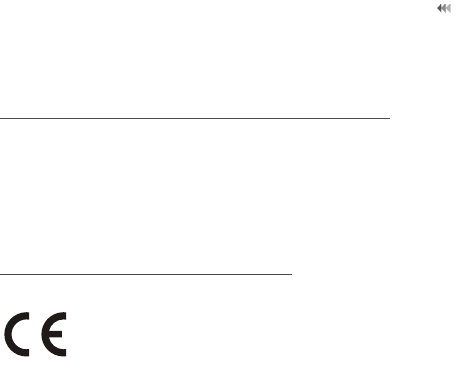
44
Warnings and Precautions
separating WEEE and batteries from other waste is to minimize the poten-
tial environmental impacts and effects on human health of any hazardous
substances that may be present.
Reduction of Hazardous Substances
This device is in compliant with the EU REACH Regulation(Regulation No
1907/2006/EC Of The European Parliament And Of The Council )and the
EU RoHS Directive (Directive 2002/95/EC Of The European Parliament
And Of The Council). For more information about the device's REACH
compliance, please visit www.huaweidevice.com/certification. You are
recommended to visit the Web site regularly for up-to-date information.
EU regulatory conformance
Hereby, Huawei Technologies Co., Ltd.
declares that this device is in compliance
with the essential requirements and other
relevant provisions of Directive
1999/5/EC.
The declaration of conformity may be
consulted at www.huaweidevice.com/certification.
Notice: Please observe the national local regulations in the location where
the device is to be used. This device may be restricted for use in some or
all countries of European Union.
0682